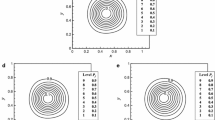Abstract
In this paper, the influence of the Mach number on the stability of two-dimensional compressible planar wakes is studied to gain physical insight into the turbine wakes. Two-dimensional instabilities of compressible wakes are studied using local spatiotemporal instability analyses. The absolute/convective boundary of a family of wake profiles is obtained at different Mach numbers. Then, local stability analyses of compressible wakes behind flat plates are performed. It is found that in the subsonic region increasing Mach number acts in two ways to modify the instability characteristics in the near wake region: it lengthens the recirculation zone and it reduces the absolute growth rate. These two mechanisms work against each other, which explains why the linear global growth rate varies slightly as Mach number changes in the subsonic region. Further increasing Mach number to 1 would greatly reduce the length of the absolute unstable region due to the occurrence of expansion waves around the trailing edge corner. As a result, the wake is strongly stabilized at \(\hbox {Ma}=1\).










Similar content being viewed by others
References
Cain, A., Ferziger, J., Reynolds, W.: Discrete orthogonal function expansions for non-uniform grids using the fast Fourier transform. J. Comput. Phys. 56(2), 272–286 (1984)
Carscallen, W.E., Fleige, H.U., Gostelow, J.P.: Transonic turbine vane wake flows. In: Turbomachinery, p. V001T01A109 (1996)
Chen, J.H., Cantwell, B.J., Mansour, N.N.: The effect of Mach number on the stability of a plane supersonic wake. Phys. Fluids A Fluid Dyn. 2(6), 984–1004 (1990)
Chomaz, J.M., Huerre, P., Redekopp, L.G.: A frequency selection criterion in spatially developing flows. Stud. Appl. Math. 84(2), 119–144 (1991)
Cicatelli, G., Sieverding, C.: The effect of vortex shedding on the unsteady pressure distribution around the trailing edge of a turbine blade. In: ASME 1996 International Gas Turbine and Aeroengine Congress and Exhibition. American Society of Mechanical Engineers Digital Collection (1996)
Hickey, J.P., Hussain, F., Wu, X.: Compressibility effects on the structural evolution of transitional high-speed planar wakes. J. Fluid Mech. 796, 5–39 (2016)
Huerre, P., Monkewitz, P.A.: Local and global instabilities in spatially developing flows. Annu. Rev. Fluid Mech. 22(1), 473–537 (1990)
Meliga, P., Sipp, D., Chomaz, J.M.: Absolute instability in axisymmetric wakes: compressible and density variation effects. J. Fluid Mech. 600, 373–401 (2008)
Meliga, P., Sipp, D., Chomaz, J.M.: Effect of compressibility on the global stability of axisymmetric wake flows. J. Fluid Mech. 660, 499–526 (2010)
Monkewitz, P.A.: The absolute and convective nature of instability in two-dimensional wakes at low Reynolds numbers. Phys. fluids 31(5), 999–1006 (1988)
Papageorgiou, D.T.: The stability of two-dimensional wakes and shear layers at high Mach numbers. Phys. Fluids A Fluid Dyn. 3(5), 793–802 (1991)
Provansal, M., Mathis, C., Boyer, L.: Bénard-von kármán instability: transient and forced regimes. J. Fluid Mech. 182(1), 1 (1987)
Schumm, M., Berger, E., Monkewitz, P.A.: Self-excited oscillations in the wake of two-dimensional bluff bodies and their control. J. Fluid Mech. 271, 17–53 (1994)
Sieverding, C.H., Richard, H., Desse, J.M.: Turbine blade trailing edge flow characteristics at high subsonic outlet Mach number. J. Turbomach. 125(2), 298–309 (2003)
Vagnoli, S.: Prediction of the unsteady turbine trailing edge wake flow characteristics and comparison with experimental data. Proc. Inst. Mech. Eng. Part A J. Power Energy 21(6), 1117–1120 (2015). https://doi.org/10.1177/0957650915592074
Watanabe, D., Maekawa, H.: Three-dimensional evolution of structure and acoustic wave generation in a compressible plane wake. Fluid Dyn. Res. 34(3), 145 (2004)
Acknowledgements
The authors acknowledge financial support from the National Science and Technology Major Project of China (No. 2017-I-0005-0006).
Author information
Authors and Affiliations
Corresponding author
Additional information
Communicated by Sergio Pirozzoli.
Publisher's Note
Springer Nature remains neutral with regard to jurisdictional claims in published maps and institutional affiliations.
Rights and permissions
About this article
Cite this article
Wang, S., Wen, F., Zhang, H. et al. Effect of Mach number on the absolute/convective stability of compressible planar wakes. Theor. Comput. Fluid Dyn. 35, 119–130 (2021). https://doi.org/10.1007/s00162-020-00554-8
Received:
Accepted:
Published:
Issue Date:
DOI: https://doi.org/10.1007/s00162-020-00554-8




